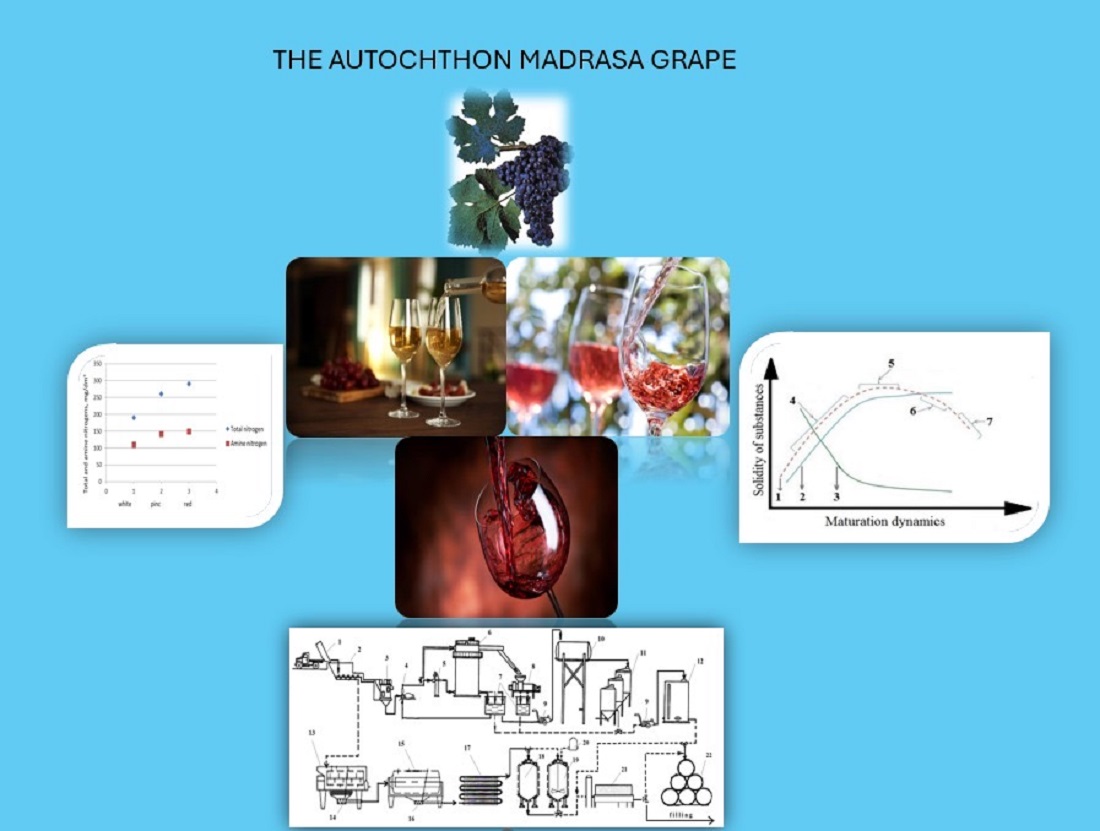Identifying of the wine-making potential of the autochthon madrasa grape variety of different colors and quality
DOI:
https://doi.org/10.15587/1729-4061.2024.302971Keywords:
red grapes, different colored wines, ripeness, active coal, Collagel Clar, white wines, pink wines, Madrasa grape, winemaking, phenolic acidsAbstract
Madrasa grape variety, juice, pulp, wine material, auxiliary materials, technological methods and tools were taken as the object of research. Madrasa is an autochthonous grape variety belonging to the Nagorno-Karabakh region of Azerbaijan. The lack of full study of the quality resources of this variety, especially its color (red, pink and white) and lack of research in the direction of producing wines that differ in quality remains a problem.
The sugar-acid index and phenolic ripeness were determined in Madrasa grape variety, reflecting the optimum ripeness.
Active color and Colagel Clar were used in order to obtain natural wines with different colors. As the dose of the drug increases, the corresponding decrease in the amount of these substances is noticed. At the dose of 80 g/hl of the drug, both total and monomer anthocyanins were not matched and the sample became colorless.
While the wine sample that was not stored and matured (control) received 7.7 points, the wine sample stored for 6 months in internally burned barrels had 7.9 points, and during that time, the internal the sample of wine stored in an unburnt barrel was rated 8.5 points. A sample of wine stored in internal fired barrels for 12 months was evaluated with 8.6 points and a sample stored in non-internally fired barrels with 8.7 points. An apparatus-technological scheme for the production of wine, which differs from the autochthonous Madrasa grape variety in terms of color and quality, has been developed. The technological scheme allows the production of wine varieties that differ in terms of gin and maturation period, based on the existing flow line for the production of red wine
References
- State program on the development of winemaking in the Republic of Azerbaijan in 2018–2025 (2018). Order of the president of the Republic of Azerbaijan No. 38. 03.05.2018. Available at: https://e-qanun.az/framework/38684
- Bronzi, B., Brilli, C., Beone, G. Maria., Fontanella, M. C., Ballabio, D. et al. (2020). Geographical identification of Chianti red wine based on ICP-MS element composition. Food Chemistry, 315, 126248. https://doi.org/10.1016/j.foodchem.2020.126248
- Di Paola-Naranjo, R. D., Baroni, M. V., Podio, N. S., Rubinstein, H. R., Fabani, M. P., Badini, R. G. et al. (2011). Fingerprints for Main Varieties of Argentinean Wines: Terroir Differentiation by Inorganic, Organic, and Stable Isotopic Analyses Coupled to Chemometrics. Journal of Agricultural and Food Chemistry, 59 (14), 7854–7865. https://doi.org/10.1021/jf2007419
- Pérez-Caballero, V., Ayala, F., Echávarri, J. F., Negueruela, A. I. (2003). Proposal for a New Standard OIV Method for Determination of Chromatic Characteristics of Wine. American Journal of Enology and Viticulture, 54 (1), 59–62. https://doi.org/10.5344/ajev.2003.54.1.59
- Sánchez-Gómez, R., del Alamo-Sanza, M., Martínez-Martínez, V., Nevares, I. (2020). Study of the role of oxygen in the evolution of red wine colour under different ageing conditions in barrels and bottles. Food Chemistry, 328, 127040. https://doi.org/10.1016/j.foodchem.2020.127040
- Casassa, L. F., Ceja, G. M., Vega-Osorno, A., du Fresne, F., Llodrá, D. (2021). Detailed chemical composition of Cabernet Sauvignon wines aged in French oak barrels coopered with three different stave bending techniques. Food Chemistry, 340, 127573. https://doi.org/10.1016/j.foodchem.2020.127573
- Haydarov, E. E., Fataliyev, H. K. (2016). Improving the technology of Red natural wines. Baku: Science, 122. Available at: https://www.adau.edu.az/images/ms_kitabxana/06_08_2021_12_10_02_189_1496105_F%C9%99t%C9%99liyev%20H.%20Q%C4%B1rm%C4%B1z%C4%B1%20natural%20%C5%9F%C9%99rab%20texnologiyas%C4%B1n%C4%B1n%20t%C9%99kmill%C9%99%C5%9Fdirilm%C9%99si.pdf
- Tamborra, P., Esti, M., Minafra, M. (2002). Color and phenolic compounds of rosé wines from red-berry varieties of South Italy. Polyphenols Communications. XXI International Conference on Polyphenols. Marrakech, 227–228. Available at: http://hdl.handle.net/2067/31386
- Fataliyev, H., Lazgiyev, Y., İmamguliyeva, M., Haydarov, E., Fataliyeva, Sh., Huseynova, Sh. et al. (2023). Comparative evaluation and studing of some indigenous and introduced red grape varieties. Food Science and Technology, 17 (2), 18–24. https://doi.org/10.15673/fst.v17i2.2595
- Fataliev, H. K. (2012). Apprentice in winemaking. Baku: Elm, 328. Available at: https://anl.az/el/Kitab/2013/Azf-272480.pdf

Downloads
Published
How to Cite
Issue
Section
License
Copyright (c) 2024 Hasil Fataliyev, Ahmad Malikov, Yusif Lezgiyev, Natavan Gadimova, Teymur Musayev, Gulshan Aliyeva

This work is licensed under a Creative Commons Attribution 4.0 International License.
The consolidation and conditions for the transfer of copyright (identification of authorship) is carried out in the License Agreement. In particular, the authors reserve the right to the authorship of their manuscript and transfer the first publication of this work to the journal under the terms of the Creative Commons CC BY license. At the same time, they have the right to conclude on their own additional agreements concerning the non-exclusive distribution of the work in the form in which it was published by this journal, but provided that the link to the first publication of the article in this journal is preserved.
A license agreement is a document in which the author warrants that he/she owns all copyright for the work (manuscript, article, etc.).
The authors, signing the License Agreement with TECHNOLOGY CENTER PC, have all rights to the further use of their work, provided that they link to our edition in which the work was published.
According to the terms of the License Agreement, the Publisher TECHNOLOGY CENTER PC does not take away your copyrights and receives permission from the authors to use and dissemination of the publication through the world's scientific resources (own electronic resources, scientometric databases, repositories, libraries, etc.).
In the absence of a signed License Agreement or in the absence of this agreement of identifiers allowing to identify the identity of the author, the editors have no right to work with the manuscript.
It is important to remember that there is another type of agreement between authors and publishers – when copyright is transferred from the authors to the publisher. In this case, the authors lose ownership of their work and may not use it in any way.









